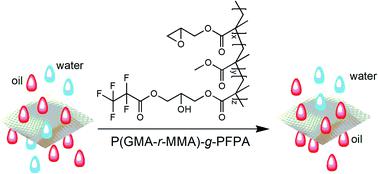Our official English website, www.x-mol.net, welcomes your feedback! (Note: you will need to create a separate account there.)
Superhydrophobic cotton fabric membrane prepared by fluoropolymers and modified nano-SiO2 used for oil/water separation
RSC Advances ( IF 3.9 ) Pub Date : 2021-09-24 , DOI: 10.1039/d1ra06393f Chengmin Hou 1 , Congjun Cao 1
RSC Advances ( IF 3.9 ) Pub Date : 2021-09-24 , DOI: 10.1039/d1ra06393f Chengmin Hou 1 , Congjun Cao 1
Affiliation

|
At present, the preparation methods of oil–water separation membranes include chemical vapor deposition, electrospinning, atom transfer radical polymerization, etc. Basically, they all have issues of low recycling rate and incontinuous use. In this paper, the epoxy polymer P(GMA-r-MMA) obtained by traditional radical polymerization of glycidyl methacrylate (GMA) monomer and methacrylic acid (MMA) monomer, and pentafluoropropionic acid (PFPA) is used to modify polymer P(GMA-r-MMA) to obtain fluorine-containing epoxy polymer P(GMA-r-MMA)-g-PFPA. Secondly, fluorine-containing epoxy polymer P(GMA-r-MMA)-g-PFPA and amino-modified nano SiO2 is blended, and the cotton fabric is dip-coated to obtain a superhydrophobic surface, thereby preparing an oil–water separation membrane. By controlling the solution concentration, dipping time, drying time and other conditions, the superhydrophobic performance of the separation membrane was characterized, and the best construction conditions for the superhydrophobic surface were obtained: 0.3 mg mL−1 polymer concentration, immersion time 6 h, drying temperature 120°, and drying time 4 h, and the maximum water contact angle can reach to 150° ± 2°. Finally, the cotton fabric was modified under the best dipping conditions, and used as an oil–water separation membrane to study the oil–water separation performance of n-hexane, n-octane, kerosene, chloroform and water mixtures in batch operation and continuous operation. In batch operations, the separation efficiency can reach 99% and can achieve 5 consecutive high-efficiency separations without intermittent drying. In continuous flow operation, oil–water separation can last for more than 12 hours and the separation efficiency can reach 98%. It also has stable oil–water separation performance for oil–water emulsion.
中文翻译:

含氟聚合物和改性纳米SiO2制备的超疏水棉织物膜用于油水分离
目前油水分离膜的制备方法有化学气相沉积法、静电纺丝法、原子转移自由基聚合法等,基本上都存在回收率低、不能连续使用的问题。本文采用甲基丙烯酸缩水甘油酯(GMA)单体和甲基丙烯酸(MMA)单体进行传统自由基聚合得到的环氧聚合物P(GMA- r -MMA),并用五氟丙酸(PFPA)对聚合物P(GMA- r -MMA) 得到含氟环氧聚合物 P( GMA- r -MMA)- g -PFPA。其次,含氟环氧聚合物P( GMA- r -MMA)- g -PFPA和氨基改性纳米SiO 2经混纺,浸涂棉织物,获得超疏水表面,从而制备油水分离膜。通过控制溶液浓度、浸渍时间、干燥时间等条件,对分离膜的超疏水性能进行表征,得到超疏水表面的最佳构建条件:0.3 mg mL -1聚合物浓度,浸渍时间6 h,干燥温度120°,干燥时间4 h,最大水接触角可达150°±2°。最后,在最佳浸渍条件下对棉织物进行改性,作为油水分离膜研究正己烷的油水分离性能, n-辛烷、煤油、氯仿和水的混合物在间歇操作和连续操作中。在间歇操作中,分离效率可达99%,可实现连续5次高效分离,无需间歇干燥。在连续流动运行中,油水分离可持续12小时以上,分离效率可达98%。对油水乳液也有稳定的油水分离性能。
更新日期:2021-09-24
中文翻译:

含氟聚合物和改性纳米SiO2制备的超疏水棉织物膜用于油水分离
目前油水分离膜的制备方法有化学气相沉积法、静电纺丝法、原子转移自由基聚合法等,基本上都存在回收率低、不能连续使用的问题。本文采用甲基丙烯酸缩水甘油酯(GMA)单体和甲基丙烯酸(MMA)单体进行传统自由基聚合得到的环氧聚合物P(GMA- r -MMA),并用五氟丙酸(PFPA)对聚合物P(GMA- r -MMA) 得到含氟环氧聚合物 P( GMA- r -MMA)- g -PFPA。其次,含氟环氧聚合物P( GMA- r -MMA)- g -PFPA和氨基改性纳米SiO 2经混纺,浸涂棉织物,获得超疏水表面,从而制备油水分离膜。通过控制溶液浓度、浸渍时间、干燥时间等条件,对分离膜的超疏水性能进行表征,得到超疏水表面的最佳构建条件:0.3 mg mL -1聚合物浓度,浸渍时间6 h,干燥温度120°,干燥时间4 h,最大水接触角可达150°±2°。最后,在最佳浸渍条件下对棉织物进行改性,作为油水分离膜研究正己烷的油水分离性能, n-辛烷、煤油、氯仿和水的混合物在间歇操作和连续操作中。在间歇操作中,分离效率可达99%,可实现连续5次高效分离,无需间歇干燥。在连续流动运行中,油水分离可持续12小时以上,分离效率可达98%。对油水乳液也有稳定的油水分离性能。



























 京公网安备 11010802027423号
京公网安备 11010802027423号